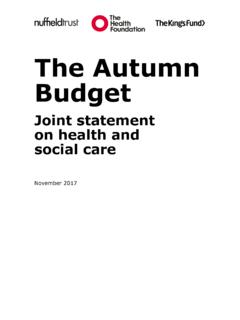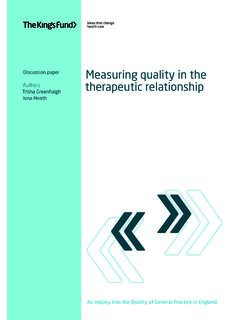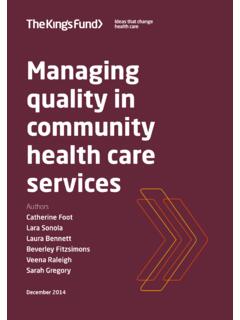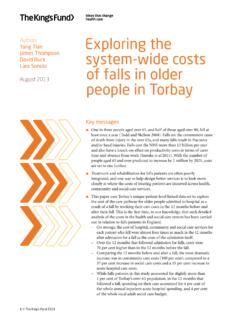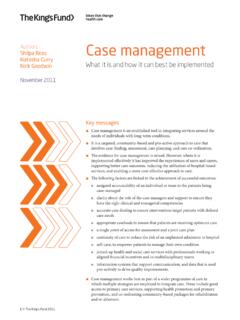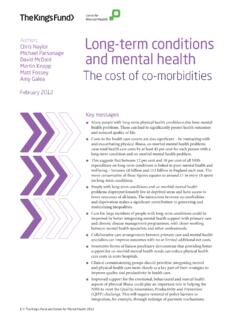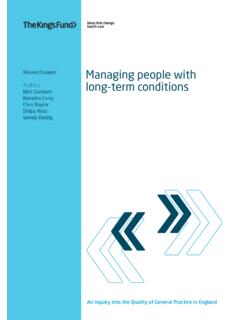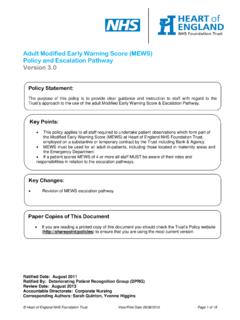Transcription of Leadership in today’s NHS
1 Leadership in today 's NHS. Delivering the impossible Siva Anandaciva Deborah Ward Mandip Randhawa Rhiannon Edge July 2018. Leadership in today 's NHS. 1 2 3 4 5 6 7 8 9. Contents Foreword 4. Key messages 7. 1 Introduction 9. 2 Survey findings 11. Vacancy levels 12. Tenure of NHS directors 14. The inverse Leadership law 16. Clinical chief executives 19. 3 Why does Leadership churn matter? 20. Supporting transformation and more strategic decision-making 20. Why organisational memory is important 22. Building greater credibility with staff 23. Balancing the opportunities and risks of long tenures 24.
2 4 How has the environment changed for NHS trusts? 26. Unrelenting financial and operational pressures 26. Regulatory burden and lack of autonomy 28. The impact of that Act' 30. Contents 1. Leadership in today 's NHS. 1 2 3 4 5 6 7 8 9. 5 How has the environment changed for individual leaders? 31. An increasing risk of regulatory decapitation' 31. More financial disincentives 34. A difficult balance between strategic and operational issues 35. 6 How are organisations and leaders reacting? 36. The quality of candidates 36. A reducing appetite for risk 38.
3 The ghettoisation of Leadership backgrounds 41. Personal characteristics of leaders 43. Reversing the inverse Leadership law 45. 7 Diverse Leadership 48. A challenging picture 48. Improving the diversity of boards 50. 8 Looking to the future different styles of Leadership 53. Clinical leaders 53. An emphasis on systems and collaborative Leadership 55. The emergence of managing directors 58. The torch has been passed 59. Contents 2. Leadership in today 's NHS. 1 2 3 4 5 6 7 8 9. 9 What can be done? 60. Build on existing national talent management and development programmes 60.
4 Rebuild regional talent management 61. Invest more time and resources in local Leadership development 64. Think about where the pipeline ultimately leads 65. A final word balancing reality with optimism 70. Appendix: Methodology 72. References 74. About the authors 79. Acknowledgements 81. Contents 3. Leadership in today 's NHS. 1 2 3 4 5 6 7 8 9. Foreword Our report on Leadership vacancies is full of important findings for the NHS. nationally, regionally and locally. The data and insights it contains really matter . high vacancy rates and turnover have a significant impact on culture, staff engagement and performance and disproportionately affect the most challenged organisations in our system.
5 It is somewhat depressing that some of these conclusions could have featured in a similar report published five or ten years ago, although much has also changed. The task, or rather the shared mission, for all leaders should be a commitment to address these issues wherever they operate in the system as no single action or investment will close the gaps we set out. Compared 2014, when The King's Fund conducted a similar analysis, the good news is that length of tenure has increased, with the average tenure for a chief executive up from two and a half years in 2014 to three years now.
6 But this is still very short and the level of churn in all the executive director posts we looked at remains worrying; the ability to recruit high-calibre chief operating officers is of particular concern with growing demands on services. Since 2014, things have moved on . a changing of the guard with many of the longest-serving chief executives having retired and a new generation of talented leaders coming through including many more clinical leaders. There have been some positive steps to improve the diversity of leaders, but there is still a huge amount to do before the NHS has Leadership teams that truly reflect the communities they serve.
7 When Aneurin Bevan spoke in the House of Commons during the second reading debate on the NHS Bill on 30 April 1946, he talked about the need to be open to take the best sort of individuals on these hospital boards which we can find, we hope before very long to build up a high tradition of hospital administration'. The ambition of employing the best people remains, yet the NHS has changed immeasurably since its birth and new models of Leadership are now required. Leadership of complex systems requires different ways of working as organisations move away from operating as separate entities towards working together in systems of care.
8 The ability to work collaboratively across organisations without being defensive about your own is now vital and many senior leaders spend as Foreword 4. Leadership in today 's NHS. 1 2 3 4 5 6 7 8 9. much time outside their organisations working with local partners as they do in their own. We found that the inverse Leadership law is still very much in force, with the most challenged organisations experiencing the biggest differences in recruiting and retaining leaders a new approach is needed to address this, focused on how best to support local teams and systems to develop their workforce.
9 Investment in national programmes should be extended to focus on roles with the most vacancies and shortest tenures. The recent Aspiring Chief Executive and Aspiring Chief Operating Officer programmes, led by NHS Improvement, NHS Providers and the NHS Leadership Academy, are a good start. Changing requirements mean that leaders themselves need to adapt or be replaced by new leaders with different approaches. But creating and developing effective pipelines of leaders needs investment and not just money. It is crucial that senior leaders across the system invest personal time and influence to embed the necessary collective and compassionate Leadership behaviours in their organisations and systems.
10 Yet exemplary Leadership development is not enough on its own to address the issues the NHS faces. If anything, pressures have increased with a cocktail of growing financial and operational pressures, unrelenting media and political attention on the NHS and an increasingly personalised approach to performance and financial failure. The NHS can develop fantastic, diverse leaders, equipped to work in the new NHS, but this investment will be wasted if those leaders are not attracted to senior roles or if those roles are, in reality, un-doable. Removing senior leaders from their roles for failing to manage the unmanageable plays a huge part in putting potential leaders off taking senior jobs and more needs to be done to improve the environments in which leaders are operating.
